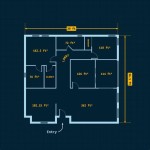Decoding the Single Room Apartment Floor Plan: Maximizing Space and Functionality
The single room apartment, often referred to as a studio apartment, presents a unique set of challenges and opportunities in interior design. Due to its limited square footage, meticulous planning and thoughtful execution are crucial to creating a comfortable, functional, and aesthetically pleasing living space. The floor plan serves as the foundational blueprint for achieving this, dictating the flow of movement, the placement of furniture, and the overall organization of the apartment. Understanding the key elements of a successful single room apartment floor plan is essential for both renters and owners seeking to optimize their living environment.
A poorly designed single room apartment can feel cramped, disorganized, and overwhelming. Conversely, a well-conceived plan can transform a small space into a surprisingly livable and enjoyable home. This article explores the critical considerations involved in developing an effective single room apartment floor plan, focusing on strategies for maximizing space, defining distinct zones, and incorporating personal style without sacrificing functionality.
Prioritizing Functionality and Defining Zones
The most significant challenge in designing a single room apartment is accommodating all the necessary residential functions – sleeping, cooking, eating, relaxing, and working – within a single, open space. The key to success lies in clearly defining zones dedicated to each of these activities. This doesn’t necessarily require physical walls or partitions; instead, visual cues and strategic furniture placement can effectively delineate different areas.
Consider the natural light sources and architectural features of the apartment when determining the placement of each zone. The sleeping area, for example, might be positioned in a darker corner to promote restful sleep, while the workspace could be placed near a window to maximize natural light and productivity. The kitchen area, typically fixed due to plumbing and appliance connections, often dictates the layout of the adjacent dining or living space.
Furniture serves as a primary tool for defining zones. A strategically placed sofa can visually separate the living area from the sleeping area. A bookshelf can act as a room divider, providing both storage and a sense of separation. Even rugs can be used to define specific zones within the larger space. By carefully selecting and positioning furniture, one can create the illusion of separate rooms within a single, open layout.
Multi-functional furniture is paramount in a single room apartment. Sofas that convert into beds, coffee tables with hidden storage, and folding dining tables are all excellent choices for maximizing space and minimizing clutter. These pieces allow a single item to serve multiple purposes, reducing the need for additional furniture and freeing up valuable floor space.
The concept of the "working triangle" is crucial in the kitchen area. This refers to the relationship between the sink, refrigerator, and stovetop. Optimizing this triangle ensures efficient movement within the kitchen and minimizes wasted steps. In a small kitchen, this may involve choosing compact appliances, such as a two-burner stovetop or a smaller refrigerator, to create a more efficient workflow.
Maximizing Vertical Space and Storage Solutions
In a single room apartment, every square inch counts. Maximizing vertical space is crucial for creating a feeling of spaciousness and minimizing clutter. This involves utilizing wall space for storage, shelving, and decorative elements.
Tall bookshelves, reaching almost to the ceiling, provide ample storage for books, personal belongings, and decorative items. Open shelving can display curated collections, adding visual interest to the space without making it feel cramped. Wall-mounted cabinets and shelves in the kitchen can free up counter space and provide additional storage for cookware and pantry items.
Consider installing floating shelves above the sofa or bed. These shelves can be used to display artwork, plants, or other decorative objects, adding personality to the space and drawing the eye upward, creating a sense of height. Using mirrors strategically can also enhance the feeling of spaciousness by reflecting light and creating the illusion of a larger room. A large mirror placed on a wall opposite a window can significantly brighten the space and make it feel more open.
Storage solutions should be integrated seamlessly into the overall design. Hidden storage compartments under the bed, ottomans with built-in storage, and wall-mounted storage units can all help to keep clutter out of sight and maximize available space. Consider using clear storage containers to easily identify the contents and keep items organized.
Utilizing the space above doorways is often overlooked. Installing shelves above doorways can provide a discreet and practical storage solution for items that are not frequently used. This space is often underutilized and can be a valuable asset in a small apartment.
Vertical gardens or wall-mounted planters can add a touch of nature to the apartment while saving valuable floor space. These can be particularly effective in small apartments where outdoor space is limited. The greenery can create a calming and refreshing atmosphere, improving the overall living environment.
Color Palette, Lighting, and Decor: Creating a Cohesive Aesthetic
The color palette, lighting, and decorative elements contribute significantly to the overall aesthetic of the single room apartment. A cohesive design scheme can create a sense of harmony and unity, making the space feel more spacious and inviting.
A light and neutral color palette is generally recommended for small spaces. Light colors reflect more light, making the room feel brighter and more open. White, cream, and pale grays are popular choices for walls and ceilings. Accents of color can be introduced through furniture, textiles, and accessories.
The use of natural light should be maximized. Avoid heavy curtains or blinds that block sunlight. Sheer curtains or blinds allow natural light to filter into the room while providing privacy. Supplement natural light with a combination of ambient, task, and accent lighting.
Ambient lighting provides overall illumination for the room. This can be achieved with ceiling fixtures, floor lamps, or table lamps. Task lighting provides focused illumination for specific activities, such as reading or working. Desk lamps, under-cabinet lighting in the kitchen, and adjustable floor lamps are examples of task lighting.
Accent lighting highlights specific features or objects in the room, such as artwork or architectural details. This can be achieved with spotlights, track lighting, or wall sconces. Accent lighting can add depth and dimension to the space, creating a more visually interesting environment.
Decorative elements, such as artwork, rugs, and throw pillows, should be carefully selected to complement the overall design scheme. Avoid cluttering the space with too many decorative items. Instead, focus on a few key pieces that add personality and visual interest. A large piece of artwork can serve as a focal point in the room, drawing the eye and creating a sense of sophistication.
Rugs can be used to define zones and add warmth and texture to the space. Choose rugs that are appropriately sized for each zone. A rug that is too small can make the space feel disjointed, while a rug that is too large can overwhelm the room.
In conclusion, designing a successful single room apartment floor plan requires careful planning and attention to detail. By prioritizing functionality, maximizing vertical space, and creating a cohesive aesthetic, one can transform a small space into a comfortable, functional, and visually appealing home.

Studio Apartment Layout In 2024 Floor Plans

Farnam Flats Has A Variety Of Floor Plan Options Available For

Studio Floor Plans Apartment Small Layout

One Bedroom Standard Floor Plan Apartments In M Massachusetts Princeton Crossing

Studio Apartment Floor Plans Examples Key Considerations Cedreo
:strip_icc()/cdn.cliqueinc.com__cache__posts__209346__how-to-lay-out-a-studio-apartment-and-have-room-to-spare-1989066-1479848042.700x0c-bdc9dbe29c1b41da9e87868b51881e72.jpg?strip=all)
One Studio Apartment 4 Ways Follow Our Stylish Guide

Studio Apartment Plan Examples

Studio 1 2 And 3 Bedrooms At Peninsula Apartments

Studio Apartment Plan Examples

Floor Plans Wh Flats Apartments
Related Posts








